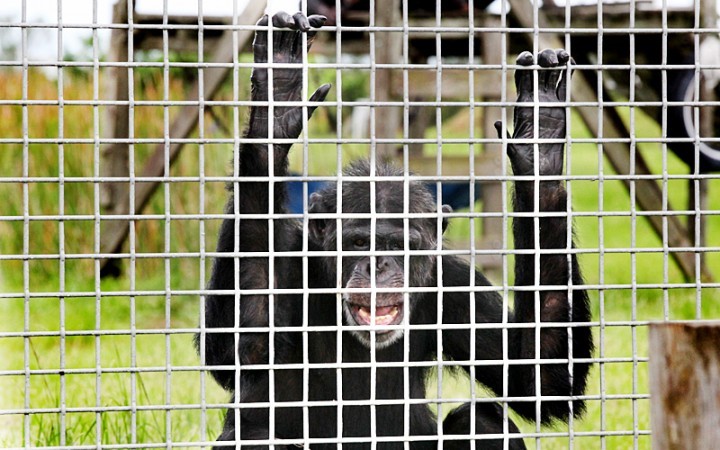
FT. PIERCE — Save the Chimps opened its well-secured gates to slightly more than 300 members Saturday, in celebration of the 10-year “Bananaversary” of the rescue of 266 chimpanzees from the Coulston Foundation, a horrifying biomedical research lab in New Mexico with a history of repeated Animal Welfare Act violations.
They hosted a similar member day last January celebrating the culmination of the Great Chimpanzee Migration and the final 19 chimps arrival at the Ft. Pierce sanctuary. Their goal is to host two each year, giving members a unique glimpse of the remarkable facility.
Save the Chimps principal priority is the welfare of its 269 residents, rescued from lives of misery in research laboratories, entertainment, and the pet trade. The lasting legacy of the late Carole Noon, the 150-acre haven is now the world’s largest chimpanzee rescue sanctuary.
“We are not built for humans; we are built for chimpanzees,” said STC executive director Philip Flynn, welcoming each group of about 30 visitors. “It’s the only place like it on the planet.”
“We have to have a limited number of people on tours to not distress and disrupt the lives of the chimps,” said Triana Romero, director of communications. “We have to be extremely sensitive to how this could impact them, so we have a controlled number per tour. Want to minimize the potential stress level.”
As guests walked the perimeter pathways, chimps called out with screeches, pant-hoots and a few Bronx cheers, some flirting and others displaying their incredible strength. Many preferred watching from a distance, relaxing on high climbing structures and grassy knolls.
The majority live cage-free lives in compatible family groups on 12 “islands in the sun,” connected to hurricane-proof buildings where Chimps prefer to sleep at night.
However, 10 special needs chimpanzees are unable to cope in large groups; their spirits shattered after years of deprivation. They are housed separately and their outdoor time is limited by shared rotations.
Funding is being sought to construct a specialized building with individual outdoor access which would allow chimps to see and interact with each other while remaining safely apart.
“We try to give them as much outdoor access as we can,” said STC sanctuary director Jen Feuerstein. “They deserve to be outdoors like the others; it’s not their fault that they can’t live in large groups. Their history of isolation and confinement and being used in biomedical research has damaged them so that they are not able to live with other chimpanzees very easily. We want to make sure that they get the same chance to walk on grass and lay in the sun.”
The design is complete, but the permitting process and fundraising are ongoing. A much welcomed donation of bulletproof bank glass will incorporate a bar-free view to the outside.
No additional chimpanzees have been acquired this year, but Feuerstein said, “If adequate resources were provided and we were able to expand and remain sustainable as an organization, we would certainly consider taking on additional chimpanzees.”
Some chimps have passed away due to age and chronic illness, but success stories, such as the one Feuerstein tells of Moesha, are encouraging. Born into captivity, she spent her entire life indoors and when rescued was pale, thin, anxious and easily distressed.
“When I look at her now she does not look like the same chimp we rescued. She’s on the chunky side, and she’s dark with a thick head of hair. She’s very confident and very sassy.”
Often, chimps who have lived in indoor isolation are hesitant about open spaces, but when her migration group was released onto the island she was first to run up the hill.
“It was amazing; I would not have expected her to be so brave,” said Feuerstein. “She made me very proud. She had never even seen grass before much less walked on it.”
“It was incredibly impressive; especially seeing the care and compassion of the people who work with them,” said Ed Smith at the end of the tour.
“I’m so glad we went; I would absolutely go back,” agreed wife Susan Smith. “I would like to support them in other ways. It’s just so sad that Carole Noon didn’t live to see the final results of her effort.”
Save the Chimps returns to the Vero Beach Hotel & Spa on Thursday, November 8 for the fourth annual Chimps Kitchen, featuring local chefs and musical entertainment, with all proceeds directly benefitting sanctuary chimps.
For more information, visit www.SaveTheChimps.org.



